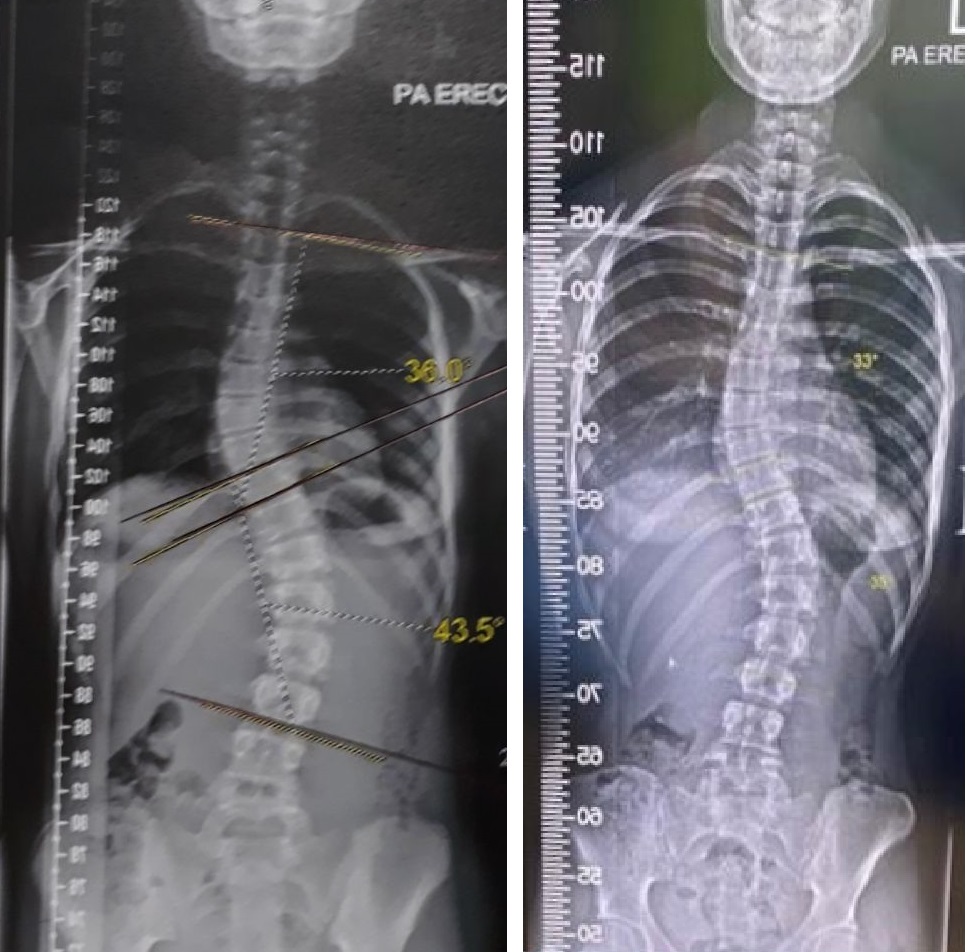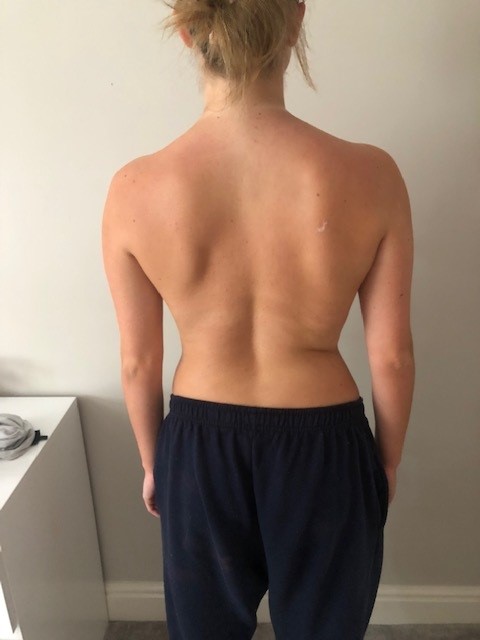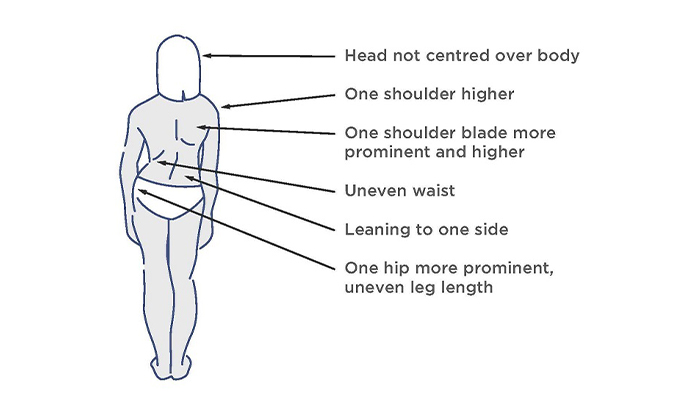
(image left) Pre treatment and (image right) Post treatment
15 September 2022
Thanks to Freya’s self-motivation and LOC’s effective non-surgical treatment for scoliosis she is now ‘discharged’
Freya was diagnosed with scoliosis by chance at the age of thirteen; she was actually in hospital due to suspected appendicitis and when her mother Victoria saw the resulting x-ray, she knew Freya had scoliosis because she had recently learnt about the condition while doing Pilates’s training. Freya had been born with hip dysplasia and had many of the symptoms of hypermobility, so it is possible this was the cause of her scoliosis. There followed a lengthy hiatus while Victoria tried to secure Freya face to face NHS appointments with physiotherapists and specialists. Freya was eventually seen by a specialist back consultant at the National Orthopaedic Hospital. The scan showed that Freya had a lumbar curve of 43.5 degrees and a thoracic curve of 36 degrees. With Cobb angles of this size the typical NHS protocol is to recommend surgery.
It was at this stage that Victoria put her foot down as she explains: “Freya was and is a very active teenager, she was a cheerleader and did lots of dancing, also she was in no pain so why opt for surgery which would put a rod in her back?”. Victoria set about doing some research into non-surgical treatments for scoliosis and found LOC. “Everyone at LOC has been fantastic; they are so encouraging and supportive. Freya was a bit concerned about what the brace would look like under clothes, so it was arranged for Freya to meet a teenager who was already in treatment; this was massively reassuring. They also did not over promise about the reduction in curve that was possible, just certain that they would sort out her posture”.

Freya was fitted with her Cheneau-Gensingen scoliosis brace on 28th April 2018. As Freya was going through a growth spurt, she needed to be seen quite frequently so that her brace could be adjusted. Victoria was impressed: “This was all part of their service as far as LOC was concerned; tiny adjustments were made so that Freya was comfortable. They explained that the better the comfort the more their scoliosis patients complied with the wearing regime required to get the results everyone wanted. Freya was highly motivated, so she wore the brace as recommended for 23 hours a day for a year and then was able to cut down gradually until she came out of her brace towards the end of 2021.”
During Freya’s treatment by LOC, she also remained under the care of the consultant at the National Orthopaedic Hospital. She was reviewed in July 2022. Victoria comments: “Her X-rays showed that the lumbar curve had reduced to 35 degrees and the thoracic to 33. The consultant was very positive about the outcome and spoke very highly about LOC which amused me as I had insisted that Freya did not have the surgery he had recommended.” As Freya has stopped growing, she is now discharged though LOC will continue to review her in a year. Victoria says: “It has been such a positive experience, Freya’s posture is so much better, her shoulders are even, her pelvis is in alignment, yes she would have liked to reduce her curves by more but as I told her, you can’t see the curve in her back now.”
Victoria is keen to help other parents who are faced by a decision as to whether to agree to surgery for their child. She is happy to be contacted which can be arranged by LOC.
Especially in young people, spotting the early signs of scoliosis is important – as is seeking early treatment. These are the warning signs to look out for:

Visual signs of Scoliosis
You can find out more about the visual signs of scoliosis here.
Find out more information about the LOC Scoliosis Brace
If you think your child, adolescent or adult family member has scoliosis, you can contact LOC directly to arrange a consultation at one of our scoliosis clinics.
If your child has recently been diagnosed with Scoliosis or you think they are showing signs of the condition, please contact us
The operation used to treat severe scoliosis curves is typically spinal fusion surgery; a major procedure that involves moving muscles and realigning the skeleton into place. The curved, deformed vertebrae are fused together into a single bone, putting metal screws and rods into the spine to help straighten it. Surgery typically lasts between 4 and 8 hours depending on the severity of the curve. Bone graft is then taken from other parts of the body and used to cover the implants.
Following the operation, it is necessary to spend around a week in intensive care before returning home and the first few days are often uncomfortable. Most adolescents can expect to return to school from 2-4 weeks following surgery, but pain medication may be required up to 6 weeks following. A full recovery from the procedure can take up to a year, as it can take that long for the spine to heal fully.
Spinal fusion surgery causes the fused portion of the back to become permanently stiff, as a result, returning to sports that require large amounts of flexibility (ballet, yoga, gymnastics, dance) or contact (rugby, football, karate, hockey) may take longer.
Risks of spinal fusion surgery are like that of any other major procedure and include infection, blood clots and anaesthesia complications. The added risks include permanent nerve damage to the spine and paralysis.